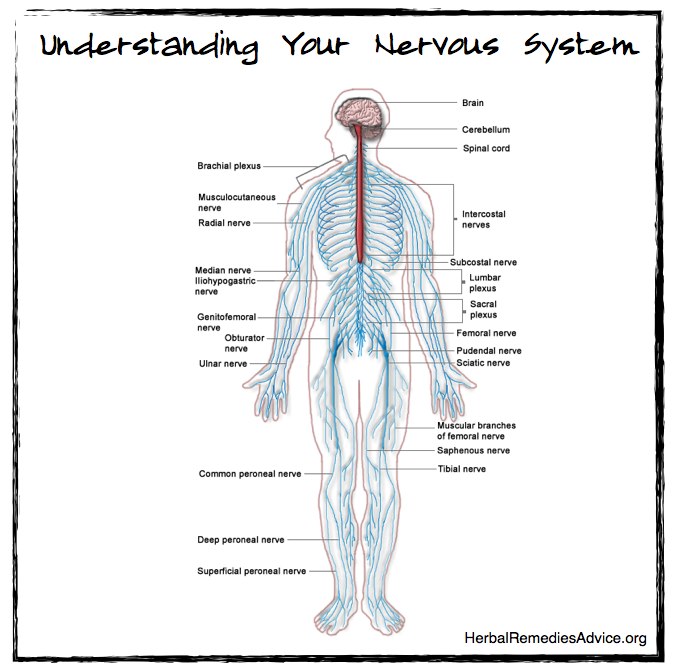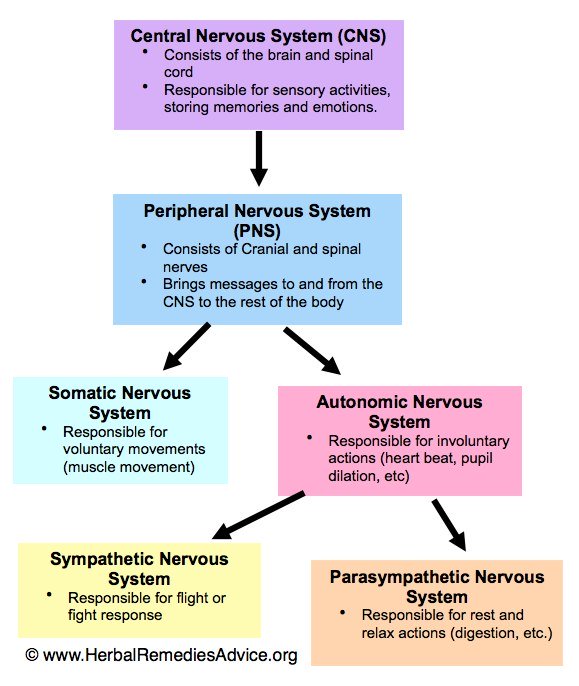Get weekly tips, recipes, and my Herbal Jumpstart e-course! Sign up for free today.

Structure of the Nervous System
Share this! |
|
The structure of the nervous system is divided into multiple systems. For you visual learners I’ve included a nervous system diagram at the end of this article.
The Central Nervous System and the Peripheral Nervous System
The structure of the nervous system is divided into two main systems: the central nervous system and the peripheral nervous system.
The central nervous system (CNS) contains the brain and the spinal cord. The central nervous system is where we receive sensory information, generate thoughts and emotions, and store memories.
The peripheral nervous system (PNS) includes the axons or nerves (i.e., bundles of axons) that originate in the brain and spinal cord and then flow out through the body into limbs and organs. Its job is to both receive and give information to and from the central nervous system.
The Somatic Nervous System and the Autonomic Nervous System
The peripheral nervous system contains within it several more divisions. It is first divided into the somatic nervous system (SNS) and the autonomic nervous system (ANS).
The somatic nervous system allows for the voluntary control of muscle and skeletal actions. It is what enables us to kick a ball or raise our hand. It also senses external stimuli such as the presence of a raindrop on our arm or the temperature of the water.
The autonomic nervous system is mostly involuntary. It regulates homeostasis in the body by controlling heart rate, digestion, pupil dilation, breathing capacity, etc.
The autonomic nervous system is divided into two more systems: the sympathetic nervous system and the parasympathetic nervous system. This structure of the nervous system is frequently discussed and examined within a holistic view of health. Some herbalists, like Michael Moore, use their understanding of these two systems as a major influence on how they practice herbalism.
The Sympathetic Nervous System
The sympathetic nervous system is responsible for the flight or fight response. When a threat is detected, our human nervous system depresses functions that are not necessary in a flight or fight scenario and increases those functions that will aid in either fleeing or fighting.
Functions of the Sympathetic Nervous System
- Increased pupil dilation to allow for better vision further away.
- Increased lung capacity.
- Increased heart rate to allow for more blood flow to the muscles, resulting in
- Increased strength and quicker movements.
- Slowed digestion by diverting blood from the digestive tract and inhibiting peristalsis.
Imagine you are a zebra on the plains of Africa. You are absentmindedly chewing some grass when suddenly you catch a strange movement from the corner of your eye. This is when the sympathetic nervous system tunes in. Your vision is increased, your heart starts beating faster, and your digestion slows. All of these actions (and many more not listed) are involuntary reactions to enable a fast get away or increased strength to stay and fight. (In this case I would suggest running!)
The Parasympathetic Nervous System
The parasympathetic nervous system is the rest-and-repair mechanism and is responsible for a lot of the healing of the body. Its functions are in many ways the opposite of the sympathetic nervous system.
After the zebra has escaped from the predator, he shakes off the sympathetic increase in energy and transitions to parasympathetic functions.
Functions of the Parasympathetic Nervous System
- Pupil constriction
- Slower heart rate
- Increased energy in the digestive tract (for nutrient absorption and elimination)
- Increased secretions such as saliva.
Summary
Although at first glance the parasympathetic nervous system and the sympathetic nervous system seem to be in opposition to each other, a better way to think of them is how they complement each other. The sympathetic nervous system speeds things up, and the parasympathetic nervous system slows things down. You need both to maintain homeostasis.
In recent years, a lot of health practitioners have been focusing on the balance between these structure of the nervous system and relating their imbalance as a cause of poor health.
As we can see in the existence of the sympathetic nervous system, our bodies are meant to deal with stress. Unfortunately they are not meant to deal with the amount and frequency of stress we commonly face today. Constant low-grade stress, or acute high-intensity stress can lead to an autonomic nervous system imbalance. In other words, it can inhibit the body’s rest-and-repair (e.g., digestion) mode while wearing out its flight or fight response (e.g., chronic hypertension leading to heart failure).
Nervous System Diagram
The following nervous system diagram is a simple table to demonstrate the overall structure of the nervous system.

Rosalee is an herbalist and author of the bestselling book Alchemy of Herbs: Transform Everyday Ingredients Into Foods & Remedies That Healand co-author of the bestselling book Wild Remedies: How to Forage Healing Foods and Craft Your Own Herbal Medicine. She's a registered herbalist with the American Herbalist Guild and has taught thousands of students through her online courses. Read about how Rosalee went from having a terminal illness to being a bestselling author in her full story here.

